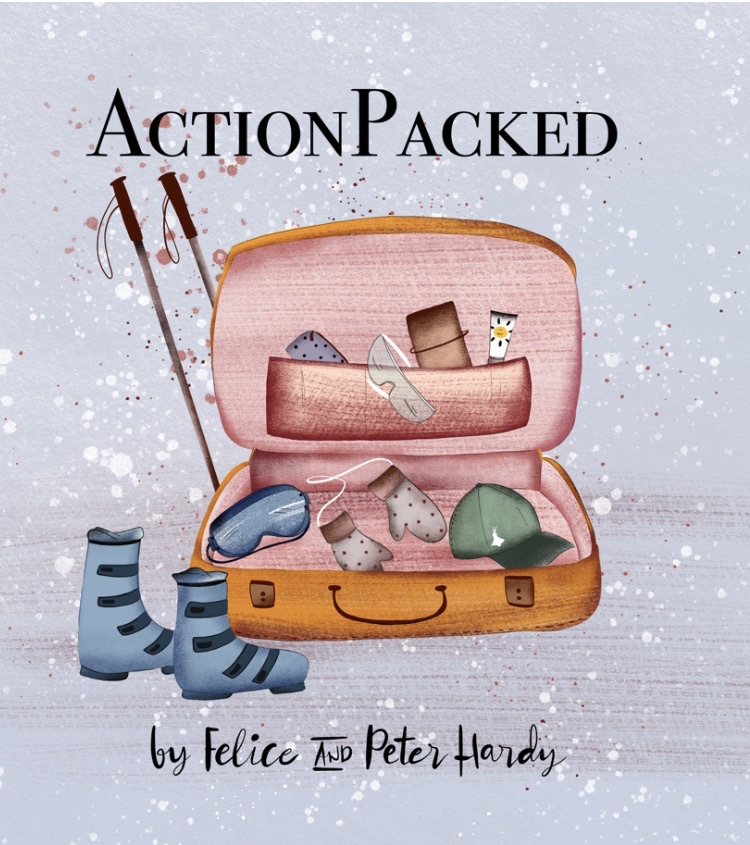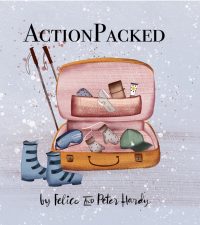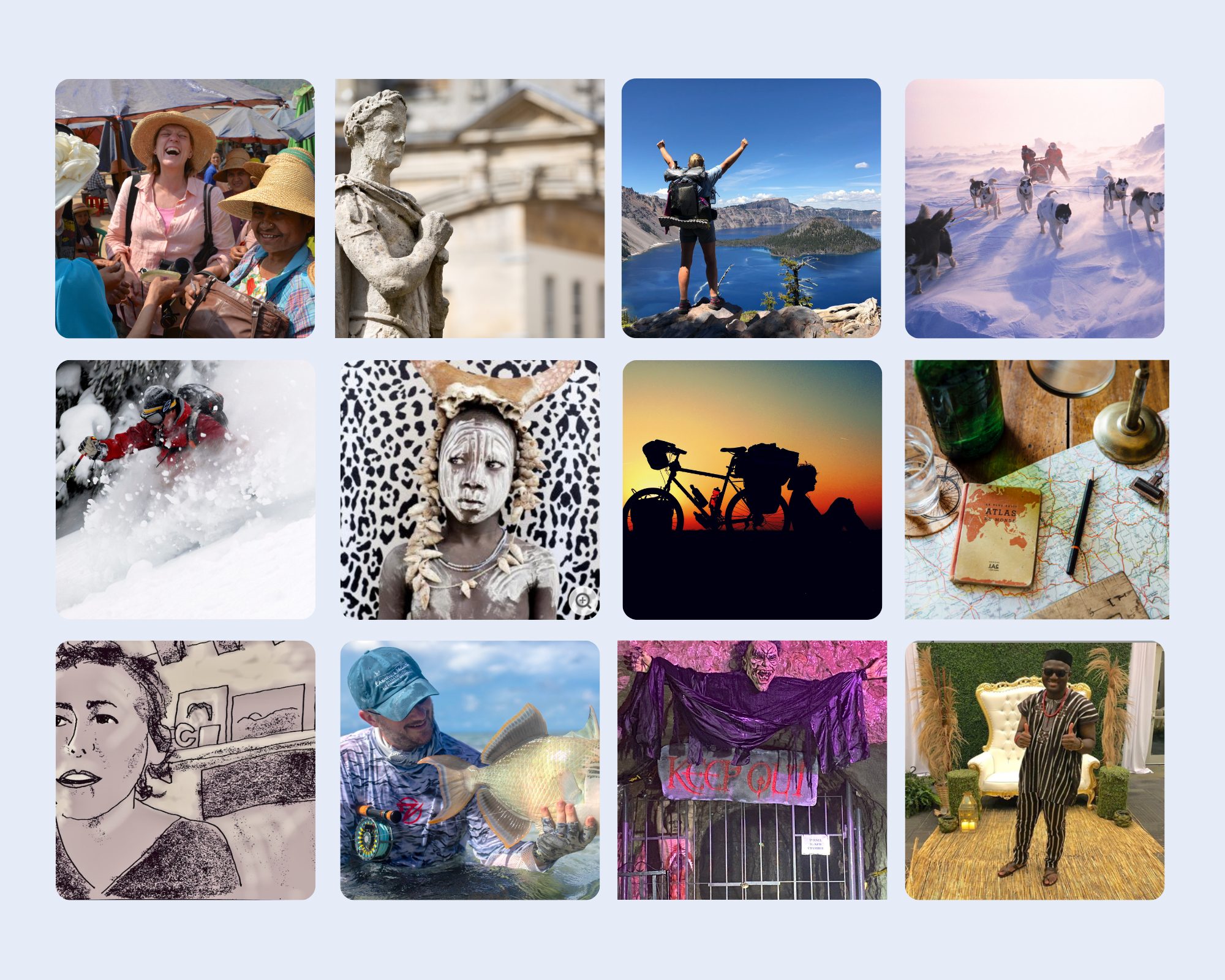
Peter H Welcome to our travel podcast. We’re specialist travel writers and we’ve spent half a lifetime exploring every corner of the world.
Felice So we want to share with you some of our extraordinary experiences and the amazing people we’ve met along the way.
Peter H We can’t believe that how years slipped by since we had our first episode of Action Packed Travel.
Felice Well, I’ve enjoyed every minute almost. I only just escaped being swept into the English Channel by a wave in Lyme Regis.
Peter H And I tripped on a first century paving stone in the flaming torchlight. I nearly dropped the recorder in the Roman baths in Bath, but it’s been a whole lot of fun.
Felice We decided to celebrate our anniversary with a look back at a dozen of our favourite episodes. Of course, there are a lot more, but we could only put a few in here. If you want to hear more of any of them, just click on Action Packed Travel and then go to Episodes. The choice is yours. Each one runs from about 15 minutes to almost an hour, with the average of around 30 minutes.
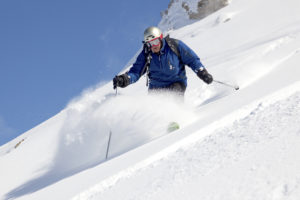
Peter H Going back to the beginning on Friday, March 13th, 2020. Our first guest was Arnie Wilson: The Man Who Has Skied More Resorts Than Anyone Else. 737 in 31 countries at the last count. Apart from the obvious states like Colorado, Wyoming, California, how many states can you actually ski in America and how many of them have you actually skied in?
Arnie Well, I took great pride in skiing every state in America where you can ski. And that goes from, you know, the wonderful places in Colorado and Utah right down to extraordinary places that nobody believes you can actually ski. And the most interesting perhaps is Alabama. People look at me as if I’m nuts. If I say skiing in Alabama and
Indeed some of these places in the more weird states, I say ‘weird’ in terms of skiing – I think they call them feeder’s breeders and leaders. And so every state which has even one tiny resort like Alabama, I can hardly call it a resort, is a breeder of skiers. And they will then go on to a feeder, which might be a bigger state. And then you get the leaders, which are obviously Colorado and California and some of the East Coast states.
So when I did this trip in 1994, skiing every day for a year, which is, as you say, is in the Guinness Book of Records, a lot of the skiing was done in America. And it’s always haunted me slightly that when that year was over, there were still a few states I hadn’t skied in. So over the years, I’ve made it a pleasure and a challenge. I have a great mate in America with whom I did this. I did three more trips to America specifically to tick off all the states where skiing is possible, which I hadn’t skied in 1994. This was fascinating because some states were unexpectedly good and some were pretty average, but I just ticked them all off and I think there are now one or two states that no longer have skiing, which did have skiing back in 1994. But there are now, I think, 38 states where it is possible to ski. And I have done them all, either once or twice or many times.
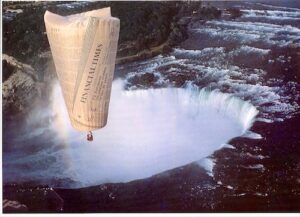
Felice In April, we met up with The Hot-Air Balloon Man, our friend, daredevil Peter Mason, who has flown balloons over almost every continent. And then he was challenged to go even higher.
Peter M At the time we were planning to do the Everest flight, there were no Oriya balloons that were designed to fly any distance and all of that kind of altitude. But talking about flying over a mountain that’s nearly 30,000 feet high. So you’re looking at a balloon that can fly at 35,000 to 40,000 feet to give clearance to the mountain. So we require that a special balloon had to be built on a special burner, also had to be built, designed specifically for the job. We put together a team of 14 crew, which included cameramen, sound technicians, engineers. On top of that, we had 20 Sherpas, 50 porters, 90 yaks, a helicopter, the high altitude plane, a lot of water.
The whole project took three years to assemble and to succeed in flying over Everest. We had two unsuccessful attempts, one of them interrupted by a crew that are in Nepal, followed by the third, which succeeded in 1991. And it was quite an achievement. I mean, no one’s ever done that flight since – and nobody needs to because you can’t break a world record for the first time twice. I mean, who remembers the second man to fly the Atlantic solo after Lindbergh.
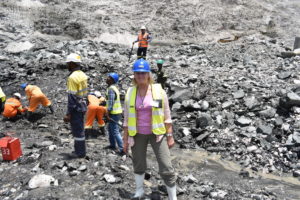
Joanna in an emerald minefield
Peter H In May, we discovered A Gem Of A Life With Joanna Hardy. Joanna is a fine jewellery specialist and regular expert on the BBC Antiques Roadshow. During her fascinating career, she’s travelled the world valuing precious stones.
Joanna We went to this one place and this lady had a whole load of gold, just loads of just gold jewellery, which was really just sort of scrap value. And then she handed me this ring and it was absolutely filthy. I could hardly see it – it was just absolutely filthy. And she said ‘This used to be my mother in law’s and just wondered what you thought.’ It was a square stone; it was blue was the size of my thumbnail. And she said: ‘A jeweller thought it might be a topaz or aquamarine.’ Anyway, she really did like talking, she just talked and talked and talked and talked and talked at you. I think she was just very pleased to see somebody because she lived on her own.
Anyway, she talked a lot in between that time. I said: ‘Do you have an old toothbrush? And could I just use your sink and some fairy liquid or some soap so I can clean the ring?’ So I went into a kitchen; she was still talking at me, and I started to clean her ring. Obviously, I put the plug in the sink. That’s that’s always what you do, when you’re cleaning any jewellery, you always make sure the plug is in the sink.
As she was talking and I was cleaning and cleaning, it was getting blue and bluer. I looked at it with my loop and it was a blue diamond. I just turned round to her and I said: ‘This is worth about £1m.’ And she stopped talking. There was silence. I just thought, oh, I should have said that earlier. She was absolutely gobsmacked: ‘I had no idea,’ and she said: ‘Oh, well, you better sell it then, please.’ So I walked out with this blue diamond worth a million pounds and I had to get it to Geneva.
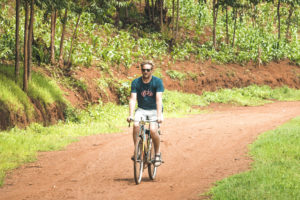
Oli cycling in Africa
Felice In June came Cycling to Australia With A Cricket Bat. In the spirit of English eccentricity, Oli Broom cycled rather slowly from London to Brisbane to watch the Ashes. His 14-month journey took him through 23 countries and he played cricket in 19 of them.
Oli In Australia, for example, coming down the Stuart Highway from Darwin, the road trains were threatening to kill me. I mean, they were horrible – pushing me off into the dust occasionally. And if the wind was swirling different ways, they’d suck you in and it would feel like you’re going to hit them. So that wasn’t very nice.
So there I really I sort of headed east towards the Gulf of Carpentaria, headed down the Barkly Tableland, and you’re probably off the beaten track. That was a great moment where I was cycling along, I’d been pushing my bike through much of the day through sort of sand that was a good few inches thick, and was on my bike when this truck came up and they just stopped next to me. And the guy who was driving. He was in the front with two others. And it was a flatbed truck, and he just leaned across his mates and he said he said: ‘Your f***ing stupid bastard.’ And and he didn’t say anything else. He just got out of his truck and he jumped up onto his flatbed and he opened the freezer that was strapped down onto the back of a flatbed. And he hurled a frozen bottle of water.
I mean, almost as hard as he could at me and didn’t say anything else, just drove off. And that was sort of outback hospitality for you. The best thing was the next day, him and his mates came back and I was on the same road and they were coming back to that. It was a big gold mining area and I suspect that’s what they were doing. And he just was very quietly pulled up beside me, didn’t say a word, handed me another water bottle and we had a good chat, a nice chat rather than off the cuff, you know, hurling abuse at me.
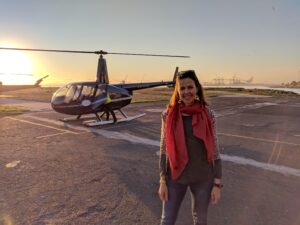
Fran in Cape Town
Peter H In July, it was Sustainable Travel With Francisca Kellett. Close encounters with angry rhinos are the most dangerous of all possible safari encounters. Fearless Fran describes herself as ‘an eco nut and a hotel junkie who spends more time in Africa than is strictly necessary’. She tells us that she ran towards the beast, not away from it, and cut off its horn so that a poacher could not.
Fran They dart it from the air. Then on the ground the team moves in very quickly and the rhino crumples down onto its knees, and in comes the vet and they do all sorts of tests. And then, literally with a chainsaw, they saw off the horn. It doesn’t hurt them at all because it’s just made of hair – the rhino’s horn – and it grows back so it doesn’t hurt them. But they are crumpled on the floor asleep while their horn is being chopped off. And then we got to do things like take blood from behind its ear. So I’ve never done anything like that obviously, never even held a syringe, and then I was there with this unconscious rhino taking a blood sample from behind its ear. I got to touch it and feel it; it was an absolutely extraordinary experience.
Felice Sounds amazing.
Fran Then, of course, once they wake up, which is only about five minutes after they go down, because they can only have a little bit of this stuff in them, and otherwise it actually effects them…once they wake up, you have to run very, very quickly because they’re angry and confused. So we had to dash back to the Land Rover and tear off while staggered around angrily. Yes, incredible.
Felice This stops people from poaching them because they only want the horns?
Fran Exactly. So I actually held this horn in my hand afterwards, and it wasn’t even a fully-grown horn because he’d been dehorned before. But this little sort of nub of the horn in the palm of my hand was worth something like 200,000 dollars. I mean, it was absolutely crazy. So they take these straight off to some safe – they’re whisked off to Jo’burg to be put in a safe, never to be seen again.
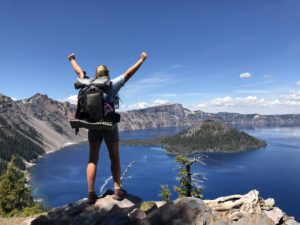
Felice Also in July, we had A Solo Hiking Adventure. Stephanie Hunt hiked the Pacific Crest Trail from the Mexican border to Canada for 2,650 miles. That’s 4,250 kilometers. It took her 155 days. I asked her about the wildlife on the trail and whether there was anything dangerous there.
Stephanie Three states have rattlesnakes and other snakes, but most of the other snakes aren’t venomous. Rattlesnakes, bears and mountain lions. So I like wildlife, I was excited to have wildlife encounters like those. So I‘m quite accustomed to hiking where there are snakes in Australia, even though I saw some rattlesnakes, they were experiences that excited me and, oh my God, I was so excited the first time I saw a bear, I was absolutely thrilled. I’d had my eyes peeled because some other people I’d passed going the other way said that they’d seen bears and it was just such a highlight. And I had run into someone, was hiking with someone at that stage and they said: ‘Oh, you’re hiking much faster now. Is it because of the bear?’ And I said: ‘Not because I’m scared of the bear,’ just that I was so excited. I was on cloud nine. I saw seven bears on the trail and I was delighted with every bear experience. I never saw a mountain lion; I would have loved to have seen a mountain lion.
Felice So was there any danger from the bears, or did you know what to do to avoid that?
Stephanie Oh, these are black bears, which are not the same as grizzly bears, they don’t have the same reputation as grizzly bears. You do have to be sensible. It’s important that you don’t get between a mother bear and her cubs. And it’s also important that you take adequate care of your food and particularly how you store your food at night. So through the Sierra, you must use a bear can and you should put your bear can away from where you camp at night. And there were other areas where that was sensible as well. I often slept with my food, though – with the bear can.
Felice What is a bear can exactly?
Stephanie It’s a canister that fits all of your food and all of your toiletries and all of your rubbish. And so they’re all the scented things that a bear might decide that it likes the smell of. And it’s got special anti-lock pouches. If you think about childproof locks on, say, medicine bottles, it’s like that only 50 times bigger. And the lock is much harder, you usually need a tool to help you open the lock because the bears are very clever and learn how to open these devices. You store it away from your tent, but you don’t store it near a cliff because they will drop them over the cliff to smash them open that way. I didn’t have any trouble, but I did encounter some other people who had all their food eaten by a bear.

Nosa in traditional dress
Peter H In August, it was From Nigeria to the USA: A Cultural Journey. We interviewed Nosa Iyare, who has his own podcast called Culture Class Podcast. Nosa emigrated to Colorado, and each week he talked to different people from different cultures. We asked him which was his favourite episode.
Nosa Oh, I mean, every episode is pretty unique. It’s pretty interesting for me, particularly because I’m generally curious and just learning something new on every episode just gives me that thrill. So every episode is almost a favourite episode. But one unique episode, particularly for my listeners and I guess for me as well, was I think that like episode 77, I interviewed a guy called Daryl Davis. Daryl Davis is this jazz musician who lives in Maryland and he’s a black man. And what he does is he interviews, he befriends members of the KKK and has been doing that for 20-something, I want to say 30 years, now. And, you know, he reaches out to them, he befriends them, hangs out with them and slowly gets them to see that…he slowly gets them to give up their ways.
I think he has been able to…he doesn’t like to use the word convert, but he’s been able to convince about 200 or so KKK clan members to disrobe and give up the ideology. He didn’t win everybody over, you know. But that was pretty interesting because I think I did that interview during the protests, which are still going on, and it just coincided with that. And there was a lot of reaction. Obviously, some people were not happy, but my point of view is, you know, there are different strategies to win the war. While for a lot of people that’s the Malcolm X approach, there’s the MLK approach, tons of approaches. So this is his approach. And he actually has results, you know, converting 200 people who are now not living their life with hate, just because of what he did. So that was pretty interesting. That was a unique episode, you know, a couple of other episodes also.
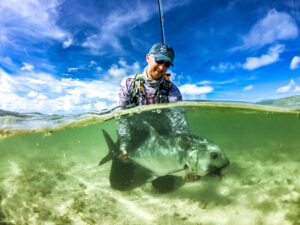
Photo: © Aardvark McLeod
Felice Also in September, we had Fly Fishing – From Trout to Trevally, which was all about Peter McLeod’s career as a fly fisherman. His search for one particular fish has taken him from India and the Seychelles to Sudan. You had any scary experiences like crocodiles or hippos or anything else that’s in the water?
Peter McL Many, yes. Well, if you are going to insert yourself into the environment of creatures which are bigger than yourself, and you spend enough time there, you’re going to have encounters. Some of those are probably far more scary than they actually are in reality. But when you are hunting trevally, for example, you spend most of your time up to your waist in water in the surf line, and you’re looking for trevally in the waves, but trevally also hang around with sharks. So if you told me 20 years ago that every time I saw a shark, I’d be running towards it instead of away from it, I wouldn’t really have believed you…but that is what we do.
Peter H So tell us about the giant trevally? I’d never actually heard of it until I looked it up this morning. This is your obsession, right?
Peter McL It is.
Peter H What is it, first of all?
Peter McL So, latin is caranx ignobilis. It is a very large kingfish species. It is an apex predator that you find on the flats, mostly through the Indian Ocean and the Pacific. They have a cousin in the Atlantic Ocean called a jack trevally. But the GTs get bigger. And I don’t know where the obsession really came from – I think anybody who’s hooked one on the fly will become obsessed immediately. Have you seen the Blue Planet on the television? Did you see the series of the fish eating birds? The footage? Many people who are listening to this may have seen that, but they will eat entire terns off the surface and they will come out of the water to eat them. There are very omnivorous fish, they will eat pretty much anything which crosses their path.
Peter H Including you, if you’re in the way?
Peter McL They’d certainly give you a nip if you get close enough, they’ve got some fairly large cordell teeth in the front and they are very predatory.
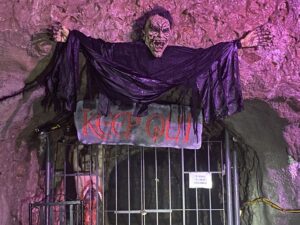
Entrance to the caves © F.Hardy
Peter H On the final day of October where else to go but to Wookey Hole. It has a complex of caves deep in the hills of Somerset in southwest England, supposedly haunted by a 1,000-year-old witch. She was blamed for every death or misfortune that befell the local community in medieval times. She finally came to grief when a young man from nearby Glastonbury, yes, home of the present day music festival, turned her to stone with a well-earned bucket of holy water. We took a private Halloween tour with David, who used to teach history at Manchester University before he became a caveman.
David I’ll lead the way. It is very dark down here. This is called Hell’s Ladder. It was thought by the ancients to lead directly to hell from which there was no return.
Peter H Let’s hope they’re wrong.
David I hope so.
Peter H Quite a low roof here. And then the cave widens out magnificently into a great cathedral-like chamber.
David We’re just venturing forward now into the Great Hall, which is a second major chamber. This is the first major chamber – it’s called the Witch’s Kitchen. Legend has it that the witch was turned to stone by a visiting priest, at the behest of the local villagers.
Peter H And when was this meant to happen?
David About 1,000 years ago. And that’s the witch stone where the witch got turned to stone by Father Bernard.
Come under here, folks, and let’s go into the Witch’s Parlour. Stay down for a bit here; don’t come up too early, that’s the key. This is the Witch’s Parlour. It’s a dome-shaped chamber formed in an interesting way by the scouring action of ancient whirlpools. It’s what gave this chamber its beautiful dome shaped appearance, is also what gives the caves beautiful acoustics, which is why we do filming here music and weddings.
Felice So do the bride and groom usually dress up as witches and wizards?
David We often have Gothic type weddings here. Haven’t had a bride dressed as a witch yet, but they tend to be quite unusual affairs.
Peter H What if you start married life down here, you can only go up really.
David Well, absolutely, the only way is up.
Felice In November, it was time for Explorer, Tom Avery: North Pole, South Pole and Verbier. Tom is one of just nine people in history to have completed the Polar trilogy – that’s reaching both the South and North Poles and a coast-to-coast crossing of Greenland. He is also the youngest Brit ever to reach both Poles. I asked him if he had any setbacks on his journey to the North Pole. And Verbier? You may well ask. He runs chalets there.
Tom Lots of things went wrong. God, I mean, the hardest part of going to the North Pole, obviously, it’s a frozen ocean. But as we know, the planet is warming and thickness of the ice cap of the Arctic Ocean is reducing year on year.
We were actually recreating the first expedition to the North Pole on our trip – it was done by an American called Robert Peary in 1909. And the thickness of the ice in his day was about 12 foot. The average thickness when we were up there was less than six foot. But sometimes the ice might only be two or three inches thick.
And it’s a really fine balance deciding whether the ice is thick enough to cross or not. And there were several times when we got it wrong and dogs, sleds, people ended up in the water. And the water temperature of the Arctic Ocean is a steady minus 1.8 degrees Celsius, which is the temperature that sea water freezes air temperature –40. And you get out of that water and it’s a battle for survival. And actually, the thing that you do to warm up again isn’t to put the tent up and get the stove going, it’s to use that adrenaline that is sweeping through you. As soon as your little toe touches that freezing cold water you’ve just got to harness it, slip back into your skis and ski off to the horizon as fast as you possibly can, get your arms and legs moving again, because actually that heat, that body heat that you can generate, is a far more effective way of raising your core body temperature than being huddled over a stove in a tent. So it’s a real case of mind over matter. We all made it, humans and dogs alike.
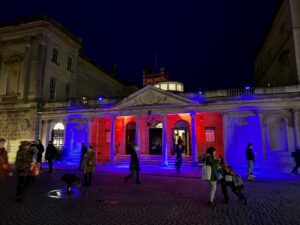
Outside The Baths © F.Hardy
Peter H In December, we found out everything you want to know about The Roman City Of Bath on a private tour by flaming torches. You could actually drink that, can you?
Jess Yes, I know it tastes a bit like…we’ve got a lot of iron in the water…it’s one of the main minerals, so it tastes quite metallic. And we’ve also got sodium chloride in there. So it’s quite salty.
People have been coming to try the waters and to swim in the baths for about 2,000 years ongoing. It’s not very refreshing. It does shock people actually, that it’s hot. The water in this fountain is 45 degrees Celsius, so it’s a little bit cooler than a cup of tea and it gets pumped up directly from the source, which is underneath the fountain, and we’ll see that later on as well, when we go around. By daylight it is bright green and this is due to the algae in the water.
So the algae love the minerals. So the algae love the minerals, they love the sunlight that they get now that the pool’s open air. But in the Roman times, this would have been covered by a large roof and so it would have been a lot darker around the Great Bath. And this means that the algae couldn’t grow, so the water would have been clearer, really.
Felice When was the last time anyone swam in it?
Jess In 1978 was the last year that anyone got in the pools and swam around. In the 1960s and ‘70s, they had Roman Rendezvous, which were parties on the summer evenings, and people would pre- purchase tickets and they would come down. There would be a band on the side playing music; people be able to get in the pool and have a swim. People also swam in the Sacred Spring, which is our other pool. But because this is where all the water comes up and it’s 46 degrees Celsius approximately, it was too hot for people to withstand more than a couple of minutes.
The Romans never swam in the Sacred Spring – that was too sacred for them. They believe that’s where Sulis Minerva lived. So they wouldn’t go in that, it was just for worship.
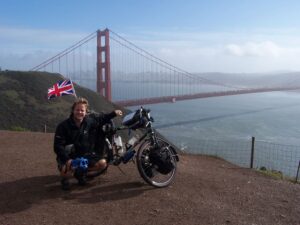
At Golden Gate Bridge, San Francisco
Felice Also in January, we discovered the Travels Of The Hungry Cyclist. Tom Kevill-Davies cycled from New York City to Rio de Janeiro. Gourmet food doesn’t seem ideal if you’re on a bike, but no, he collected recipes along the way. Here he’s in Mexico making his way down Baja, California, on the coast road south of Tijuana.
Tom It’s very hard cycling. It’s mountainous, desert, cactus forest, so you’re getting a lot of punctures. There is no shade and the only other people on the road are just heavy trucks or motorhomes of Americans who are driving down to the southern beaches to escape the winter. And they’re pretty unforgiving. And you sleep in the desert. It’s just hard, hard work.
But when you get to the inside of the peninsula, the Sea of Cortez, and they have all this fishing; the fishing there is one of the most abundant oceans in the world – or seas in the world. And it’s full of all these lovely fish. And the fishermen there, they basically sell their catch to people who sell fish tacos, which is just morsels of the lovely fish that are deep fried and served in a tortilla. But then you add various salsas and sauces, and they’re only served in the morning when the fish is fresh.
So if you can imagine, you’ve been cycling about 100 miles in the desert the day before, you sleep rough in the desert, wake up at about 6am and arrive in the next fishing village. And then there’s this lovely lady in a kind of makeshift kitchen stand selling this wonderful fish tacos and I’d just eat hundreds and hundreds of them. They were absolutely delicious, so fresh, so lovely and local. Wonderful.

Olivia Colman © John-Paul Flintoff
Felice In January, we had John-Paul Flintoff: An Eventful Life. When Covid came along, this master of the arts reached for his sketchbook.
J-P Well, the funny thing is that just before lockdown I was asked to do portraits of the people in my local parish. So I drew 35 people in different places in the church. And then just as that was about to come out, lockdown arrived and a members’ club in Soho, the Union Club, asked if I would draw members of the club as a kind of ‘let’s keep everybody in each other’s mind’ and also fundraising. So they paid for me to draw their portrait live on Zoom and the money went to Soho homeless charity.
And it was such fun because I would have these people who I didn’t know just pop onto my screen, had to draw them there and then and talk to them. And one of them was late…sort of slightly missed the deadline. And it was a person called Olivia Colman. And I thought, OK.
She said, ‘Hi, it’s Olivia Colman. I’m sorry, I missed the deadline.’ And I though, that’s ok, it doesn’t matter about the deadline. But I had no idea whether it was like the Olivia Colman or not until the last minute and I didn’t want to let on my face, I didn’t want any sign of disappointment if it was another Olivia Colman. And so when the one who has actually won an Academy Award popped up on my zoom, it was massively intimidating but also gratifying and like everyone else, they were all great. But I had a nice conversation and drew her picture. So that was strange. But it was also a little bit like being a journalist and doing an interview. It was like this. It was like me seeing you and having a chat and sharing what’s going on.
Peter H And also a little bit like sitting beneath the Eiffel Tower and drawing cartoon pictures of people who came by.
J-P Very, very much like that. You don’t exactly choose who you’re doing or what their setting is going to be. One thing I learned quite quickly was that if you draw people on Zoom, they’re likely to be fairly square on to you – you get head, shoulders and a fairly plain background. So I started asking people if they would sit well back from the computer and sort of turn sideways in their chair to try to channel my own inner National Portrait Gallery idea about what a good composition was. And they were much better. But it felt strange for everyone to be on Zoom but sitting way back over there.
Peter H Well the portrayal of Olivia Colman is great. Did she like it?
J-P She seemed really, really delighted. Yes, I was very happy. What a nice person.
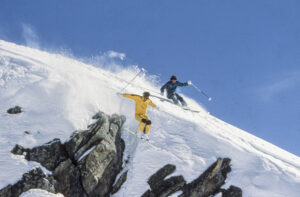
Dan launching off the cornice
Peter H In February, we met up with our old friend Dan Egan, Extreme Skiing Pioneer, one of the greatest American freeriders who for the past 30 years has been making seemingly impossible first ascents all over the world. He and his brother set out to climb Mount Elbrus by the Caspian Sea, the highest mountain in Europe.
Dan It’s one of the seven summits of the world. And oddly enough, Elbrus kills more people than Everest. On our trip, and back in 1990, that truly was the case – we lost over 30 climbers. There were 50 people trapped in the storm and I was among those trapped. We were trapped somewhere around 17,000 feet and I was 38 hours without food or water.
Felice And how did you survive?
Dan Well, I was with three other climbers from my expedition and we had joined up with a group of Russians and we had dug snow caves for the night. But the snow caves are really spread out and it was 100mph winds, snowed five feet that night. My two fellow climbers went to another snow cave and never told me, so I was abandoned in my cave. And one of the Russians must have taken a head count because he went out in the storm and found my cave, and in the middle of the night came into the cave and I believe saved my life. He huddled with me, warmed me back up, I was having visions, I had seen the bright light. And Sasha said to me, ‘Tonight, we sleep like brothers,’ and we survived the night.

Katherine Arnold © Matilda Temperley
Felice Finally, in March, at the end of our very first year, Action Packed’s Louise Hall met up with Matilda Temperley, Action Woman Behind The Lens. Tilly is a top fashion and travel photographer. She started out as a scientist in Africa before completely switching careers.
Matilda I was wondering what it really was that I did want to do. And I was racking my brains and I was thinking, ‘What have I enjoyed in life? OK, this is not going to be my life, so what is it that I can do?’ And I couldn’t really remember what my ambitions were when I was young.
When I was really young, I wanted to be a photographer and a trapeze artist, and so it was a time when I was realising the power of photography to tell stories. So I moved back to London not long after and called myself a photographer. I knew nothing and started learning the trapeze.
It was a roundabout route and everybody I was working with at the time was completely and utterly horrified. I learnt the trapeze and I loved it. I’ve got a trapeze here in my kitchen. I did my second performance. I was too old when I started, really. But I still love hanging on it, stretching. It’s like a meditation. But in my second performance in front of 450 people, I had tonsillitis and my boyfriend at the time who I’d persuaded to become a trapeze artist too, dropped me and I managed to break quite a few ribs in my back and that was the end of that. But one of my absolute best friends in the world is a trapeze artist; she’s called Katherine Arnold and all her hashtags are just Katherine Arnold. And so I live vicariously through her now.
Louise What’s the maddest thing you’ve done for work?
Matilda The maddest thing? I think I had loads of mad adventures. I found myself in a documentary in Vegas completely randomly interviewing in bed an amazing – she was in her 80s at the time – burlesque artist called Tempest Storm, who was a one-time girlfriend of Elvis. So I was lying in her bed and she was telling me all about her love affair with Elvis. I used to get flown all over the place to photograph such amazing mad situations.
Felice That’s all for now. If you’ve enjoyed the show, please share this episode with at least one other person! Do also subscribe on Spotify, i-Tunes or any of the many podcast providers – where you can give us a rating. You can subscribe on Spotify, Apple Podcasts or any of the many podcast platforms. You can also find us on Twitter, Facebook and Instagram. We’d love you to sign up for our regular emails to [email protected].
© ActionPacked Travel
![]()
- Join over a hundred thousand podcasters already using Buzzsprout to get their message out to the world.
- Following the link lets Buzzsprout know we sent you, gets you a $20 Amazon gift card if you sign up for a paid plan, and helps support our show.
